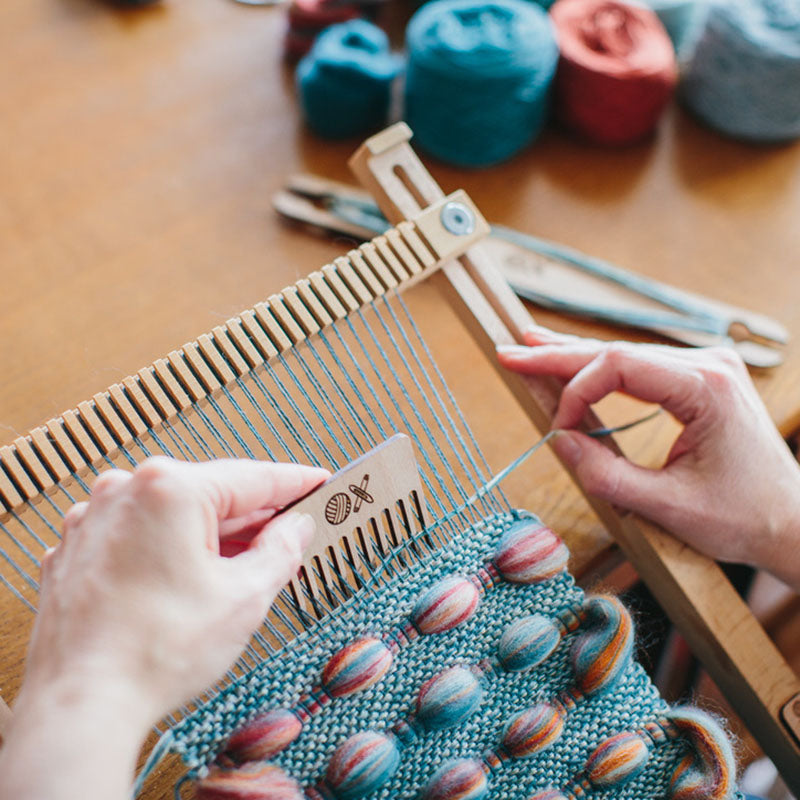
What is Frame Loom Weaving?
Share

To understand what frame loom weaving is, it helps to start with the basics of frame looms themselves.
A frame loom is the most fundamental type of weaving loom, traditionally used to create woven designs. Historically, these looms were small and portable—often made from wood and resembling a picture frame. They were originally designed for tapestry weaving, producing dense, rug-like textiles.
Modern Frame Looms: More Than Just a Simple Tool
Today, frame looms come in a wide variety of shapes, sizes, and materials. From laser-cut acrylic and MDF to hand-crafted hardwoods and DIY wood-and-nail setups, frame looms are more accessible and versatile than ever. Some are enhanced with features that increase functionality—such as tension control, wider weaving widths, and adaptable warp setts.
Each type of loom has its own advantages and drawbacks (which I’ll explore in a future post!), but what makes frame loom weaving particularly exciting is its evolution. It now bridges the gap between tapestry weaving and hand-weaving, blending techniques and aesthetics from both worlds.
Not Sure What Tapestry Weaving or Hand-Weaving Is?
If you're a novice weaver and aren't yet familiar with the difference between these styles—or the types of looms used beyond frame looms - I highly recommend checking out two foundational blog posts:
These posts offer essential context on the tools and techniques that shape each weaving style.
But if you're short on time, here’s a quick breakdown:
Tapestry weaving uses short, thick yarns (often of a single fibre) to create dense, textured designs where you essentially “draw with yarn.” It’s typically done slowly by hand using a frame loom or floor loom.
Hand-weaving, on the other hand, involves long, continuous yarns of varying textures and is used to create finer or chunkier textiles with repeating patterns. It’s usually done on more complex looms like rigid heddle, table, or floor looms—which help speed up the process.


The handwoven lampshade is woven on a floor loom by Cassandra Smith

Handwoven indigo textiles are woven on a table loom by Sarah Podlesny of Aviary Studio
Frame Loom Weaving in Contemporary Practice
In the past decade, weaving has surged in popularity within the arts and crafts world. As formal weaving education has become less accessible, more makers have turned to frame looms for their ease of use, portability, and affordability.
At the same time, artists and designers have pushed the boundaries of what frame looms can do. They've begun incorporating features once exclusive to more advanced looms—enabling longer projects, adjustable warp tension, and more intricate designs.
As a result, frame loom weaving has emerged as a distinct and versatile style. It’s no longer defined by limitations, but by personal creativity and design choice.
Meet the Makers Redefining Frame Loom Weaving
Here are just a few contemporary weavers who’ve helped shape this evolving style of frame loom weaving:
-
Christabel Balfour – Rug woven on a tapestry frame loom of her own design
-
Tammy Kanat – Circular weaving on an irregular copper frame
- Jen Duffin (Nova Mercury) – Rainbow wall-hangings on a rectangular frame loom
-
Cassandra Smith (Cassandra Sabo Designs) – Scarf woven on The Oxford Frame Loom, a loom of her own design
These artists highlight how frame loom weaving is not just a technique—it’s an expression of personal style and innovation.




Why Frame Loom Weaving is Here to Stay
Although still relatively new compared to traditional looms, frame looms have quickly gained a loyal following. Their simplicity, flexibility, and creative potential make them a favourite among beginners and experienced weavers alike.
Want to Learn More?
If you’re curious about our own frame loom design, The Oxford Frame Loom, and how it helps bridge the gap between tapestry weaving and hand-weaving, head over to our product page to discover all its features.
Or, if you’d prefer hands-on learning, check out our most popular workshop:
Introduction to Frame Loom Weaving – the perfect starting point for anyone eager to explore the art of weaving.
